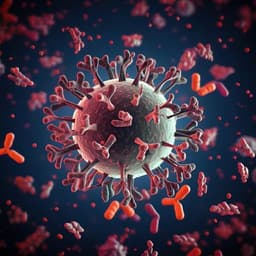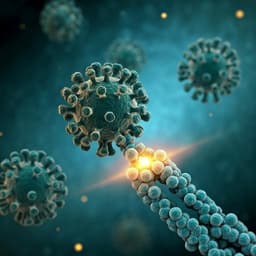
Medicine and Health
An engineered ACE2 decoy neutralizes SARS-CoV-2 Omicron BA.5 in vitro and in vivo
H. B., L. G. W., et al.
SARS-CoV-2 continues to evolve, challenging antibody responses. Researchers, including Havranek, Lee, Procko, and others, have developed FLIF, a soluble ACE2 decoy that showcases remarkable neutralization capabilities against the Delta and Omicron variants, including BA.5. This innovative approach has the potential to serve as a therapeutic solution for coronaviruses.
~3 min • Beginner • English
Introduction
Literature Review
Methodology
Plasmids: pcDNA3-sACE2-WT(732)-IgG1 (human ACE2 residues 1–732 fused to human IgG1 Fc; Addgene #154104) served as template to introduce the FLIF mutations (T27F, Q42L, L79I, N330F) by overlap extension PCR. Plasmids for myc-tagged BA.2 Spike and delta RBD-8h and for Spike-ΔC19 of SARS-CoV-2 variants (D614G, Delta, BA.1, BA.2, BA.4/5) and sarbecoviruses (SARS-CoV-1, PG-GD-1, PG-GX-P5L, RsSHO014, WIV1) were as previously described.
Flow cytometry binding: Expi293F cells were cultured at 37 °C, 125 rpm, 8% CO₂ in Expi293 medium. Cells at 2×10^6/ml were transfected with 500 ng/ml pcDNA3-myc-S (BA.2) using ExpiFectamine 293. At 24–28 h post-transfection, cells were washed with PBS + 0.2% BSA and incubated 30 min on ice with serial dilutions of sACE2-IgG1 in PBS-BSA. After washing, cells were stained 30 min on ice with anti-human IgG1-APC (1/250) and anti-myc FITC (1/100), washed, and analyzed on a BD Accuri C6. Mean APC fluorescence minus background quantified sACE2-IgG1 binding.
Protein expression/purification: sACE2-IgG1 proteins were transiently expressed in Expi293F cells (expected fully glycosylated; glycosylation sites preserved). At 2×10^6/ml, 500 ng/ml plasmid was complexed with 3 µg/ml PEI (MW 25,000) in OptiMEM for 20 min and added to cells; transfection enhancers were added after 16–22 h. Supernatant was harvested after 6–7 days, clarified (600×g 20 min 4 °C; 18,000×g 25 min 4 °C), bound to KanCapA 3G resin 1–2 h at 4 °C, washed with PBS, and eluted with 60 mM sodium acetate pH 3.7, neutralized with 1 M Tris base. Proteins were polished by SEC (Superdex 200 Increase 10/300 GL) in PBS; peak fractions pooled and quantified by A280.
BioLayer interferometry (BLI): sACE2-IgG1 immobilized on anti-human IgG Fc biosensors in assay buffer (10 mM HEPES pH 7.6, 150 mM NaCl, 3 mM EDTA, 0.05% polysorbate 20, 0.5% NFDM). Baseline 30 s, association to delta RBD-8h 60 s, dissociation 300 s. Data acquired on Octet RED96a, globally fit with 1:1 model.
Pseudotyped virus neutralization: Luciferase reporter lentiviral pseudoviruses were generated by co-transfecting LentiX-293T with pcDNA4TO Spike-ΔC19, psPAX2, and pLenti firefly using Lipofectamine 3000. Supernatants were collected at 48 h, filtered (0.45 µm), and stored at −80 °C. 293T/ACE2 cells (10,000/well, 96-well) were infected with pseudovirus preincubated 1 h with 3-fold serial dilutions of agents; medium was changed after 1 h. At 48 h, luciferase was measured with ONE-Glo on Tecan Infinite F200 Pro. Four technical replicates; nonlinear regression in GraphPad Prism 9.
Live SARS-CoV-2 neutralization: Vero-TMPRSS2 cells (80,000/well, 24-well) were infected at MOI 0.1 with SARS-CoV-2 plus protein. After 2 h, inoculum was removed, cells washed, and incubated 22 h. Supernatants were collected for qRT-PCR.
In vivo efficacy: Male Syrian hamsters (4 weeks old) were anesthetized and challenged intranasally with 1.0×10^4 PFU (60 µL). At 2 h post infection, recombinant proteins (20 mg/kg) were given intraperitoneally. On day 5 post infection, animals were euthanized and lungs collected for qRT-PCR. Animal studies were approved by Osaka University IACUC (R02-08-0).
qRT-PCR (in vivo): Total RNA from lung homogenates was isolated (ISOGENE II). One-step real-time RT-PCR (Power SYBR Green RNA-to-CT) on Agilent AriaMx. Relative quantification by 2^-ΔΔCT normalized to β-actin. Primer sets used: β-actin, 2019-nCoV_N2, IL-6, MIP1α, CCL5, CXCL10 (sequences provided).
Molecular dynamics (MD) simulations: Conventional MD using AMBER 20 with ff19SB, OPC water, and 0.15 M NaCl. Systems: WT (PDB 6M0J) and designed FFWF/FLIF ACE2 complexes; BA.4/5 modeled from PDB 7ZF7 (BA.2 RBD:ACE2) with BA.4/5 RBD mutations and ACE2 FLIF mutations introduced via CHARMM-GUI. Solvated in a rectangular water box with 10 Å buffer; ~319,512 atoms, ~75,000 waters, 137 Å cubic box. Energy minimization: 5,000 cycles steepest descent + 5,000 cycles conjugate gradient. Equilibration: 2 ns NVT with 1 kcal/mol positional restraints at 303.15 K (Langevin thermostat). Production: four 100 ns NPT replicates (303.15 K, 1 atm, Langevin γ=1.0 ps^-1, Monte Carlo barostat), 2 fs timestep, SHAKE on bonds to H, PME electrostatics, 10 Å nonbonded cutoff. Additional 200 ns trajectories used for atomistic rationale. Volumetric maps generated in VMD VolMap (occupancy threshold 0.5).
MM/GBSA: Binding free energies from 125 frames sampled from the last 50 ns of each 100 ns trajectory (first 50 ns discarded). Generalized Born (igb=5, mbondi2 radii), solvent/solute dielectric 78.5/1.0, salt 0.15 M, SASA γ=0.0072 kcal/mol/Å^2, β=0. Entropy neglected. Binding enthalpies averaged over four replicates.
Absolute binding free energy (ABFE): CL-FEP approach. Structures: WT RBD (6M0J), Omicron BA.1 (7WBP), BA.2 (7ZF7), BA.4/5 modeled from 7ZF7 with specific mutations; ACE2 FLIF mutations introduced via CHARMM-GUI. Separate simulations for RBD only, ACE2 only, complex, and bulk solvent. Each box: 10,000-step minimization; 0.15 ns NVT + 0.25 ns NPT equilibration; production 3×100 ns (total 300 ns per box; 900 ns per ABFE). NAMD 2.14, CHARMM36m, TIP3P water; 300 K, 1 atm, 0.10 M NaCl; Langevin pressure control; PME with 12 Å cutoff. Harmonic RMSD wall restraints (100 kcal/mol·Å^−2) and COM restraints (max 5 Å, 50 kcal/mol·Å^−2). CL-FEP analysis with osr=345, second-order cumulant estimator (C2), average among converged checkpoints; SD < 1 kcal/mol.
Rosetta design: Based on PDB 6M0J. Relaxation with coordinate constraints (10 runs), minimization with beta_nov16 energy. Introduced T27F and N330F mutations; redesigned ACE2 residues within 5 Å of the RBD interface (all except S19, K31, F27, F330) using Coupled Moves flexible-backbone protocol; RBD residues repacked; interface minimization. 100 design simulations; top 10% by lowest cross-interface pairwise interaction scores were selected for further evaluation. Scripts provided in SI.
Statistics/reproducibility: Analyses in GraphPad Prism 9. ANOVA with Tukey’s post hoc for MM/GBSA comparisons. Replication: pseudovirus neutralization (n=4 technical), live BA.5 neutralization (n=3 technical), hamster infection (control n=6, treatment n=3), flow cytometry (3 biological replicates), MM/GBSA (4 MD replicates), CL-FEP (3 MD replicates per box; analysis repeated 10× for WT ACE2 and 3× for FLIF).
Key Findings
Molecular dynamics and structural rationale: Volumetric mapping showed that in Wuhan RBD, Q498 and N501 form a triangular triad with ACE2 K353; D38 and E37 face opposite directions. In BA.4/5 with WT ACE2, R498 and Y501 adopt a more vertical orientation; K353 moves away from R498/Y501, and D38 moves closer to E37, both moving toward K353 and away from RBD residues. In BA.4/5 with the FLIF mutant, R498 is directed more toward FLIF. These simulations align with prior studies (Starr et al.).
Interface remodeling by FLIF mutations (T27F, Q42L, L79I, N330F):
- WT ACE2–BA.4/5 native contacts (within 3.5 Å): T27–F456 (f=42%, r=2.98 Å), T27–Y489 (40%, 3.06 Å), T27–Y473 (24%, 3.24 Å), T27–A475 (24%, 3.08 Å), Q42–R498 (15%, 3.20 Å), N330–T500 (29%, 3.01 Å). No contacts for L79 within 3.5 Å.
- FLIF–BA.4/5 native contacts: F27–A475 (44%, 3.28 Å), F27–F456 (37%, 3.07 Å; π–π stacking), L42–R498 (22%, 2.97 Å; shortened distance vs WT), I79–V486 (30%, 3.23 Å; new hydrophobic contact), F330–T500 (25%, 3.09 Å). These indicate improved hydrophobic packing and shape complementarity.
Hydrogen-bond network strengthening (occupancy f, distance r, angle θ):
- WT ACE2–BA.4/5: Lys353–Gly502 (75%, 2.94 Å, 159.49°); Tyr83–Asn487 (47%, 2.77 Å, 158.35°); Ser19–Ala475 (54%, 2.76 Å, 160.74°); Glu35–Gln493 (23%, 2.98 Å, 161.29°); Tyr41–Thr500 (22%, 2.91 Å, 158.19°).
- FLIF–BA.4/5: Lys353–Gly502 (95%, 2.92 Å, 159.27°); Tyr83–Asn487 (75%, 2.76 Å, 159.62°); Ser19–Ala475 (75%, 2.76 Å, 160.83°); Glu35–Gln493 (30%, 2.99 Å, 161.14°); Tyr41–Thr500 (26%, 2.86 Å, 159.53°). Overall, hydrogen bond occupancies increased in FLIF, consistent with improved packing.
Epistasis: The combined N501Y and Q498R mutations in BA.4/5 RBD create an epistatic context that allows the FLIF decoy to bind more strongly to BA.4/5 RBD than WT ACE2.
Efficacy and breadth: FLIF, an affinity-matured sACE2 decoy, retains tight binding to Omicron subvariants including BA.5 and potently neutralizes BA.5 in vitro and in vivo. It also neutralized sarbecoviruses from both SARS-CoV and SARS-CoV-2 clades, supporting pan-coronavirus potential. Compared with non-affinity-enhanced WT sACE2, affinity-enhanced decoys like FLIF showed marked advantages against BA.5 in vitro and in vivo.
Design balance: Despite engineering for high affinity (picomolar to delta RBD), FLIF maintained breadth across evolving variants, indicating it was not over-optimized at the expense of breadth.
Catalytic activity: FLIF preserves catalytic ACE2 residues, potentially offering therapeutic benefits via both viral neutralization and modulation of ACE2 substrates implicated in lung injury and inflammation.
Discussion
SARS-CoV-2 continues to evolve with subvariants such as Omicron BA.5 exhibiting substantial immune escape, rendering many monoclonal antibodies ineffective and challenging vaccine-induced protection. In this context, ACE2 decoy receptors represent mutation-resilient therapeutics by competing with cellular ACE2 and leveraging conserved receptor-binding interactions. The authors employed an orthogonal strategy—computational design, MD simulations with free-energy calculations, and experimental validation—to create the FLIF sACE2 decoy that achieves high affinity while maintaining breadth against circulating variants and sarbecoviruses. MD simulations and contact analyses indicate that FLIF mutations enhance hydrophobic packing and strengthen the ACE2–RBD hydrogen-bond network, particularly in the BA.4/5 background shaped by N501Y and Q498R epistasis, leading to stronger binding than WT ACE2. Experimentally, FLIF maintained potent binding and neutralization against BA.5 in vitro and showed efficacy in vivo in hamsters. Compared to wild-type sACE2, affinity-enhanced decoys like FLIF provided a marked advantage against BA.5, addressing the need for pan-coronavirus therapeutics resilient to mutational escape. The results underscore that careful engineering can preserve breadth without over-optimization and that preserving ACE2 catalytic activity may confer added therapeutic benefit via mitigation of lung injury.
Conclusion
An integrated computational–experimental approach yielded the FLIF sACE2 decoy with tight binding to SARS-CoV-2 delta and Omicron variants, including BA.5, and demonstrated neutralization in vitro and in vivo. Mechanistically, enhanced hydrophobic packing and a strengthened hydrogen-bond network at the ACE2–RBD interface, in the context of BA.4/5 epistasis, explain the affinity gains over WT ACE2. FLIF also neutralized diverse sarbecoviruses, supporting its promise as a pan-coronavirus therapeutic. These findings highlight the maturity of computational design and free energy methods for antiviral protein engineering and suggest ACE2 decoys can remain effective against future SARS-CoV-2 variants. Future work should assess therapeutic windows, dosing regimens that better mimic clinical settings, efficacy against more pathogenic variants or models, and the clinical impact of preserving ACE2 catalytic activity.
Limitations
In vivo Omicron infections yield attenuated disease in mice and hamsters, limiting assessment of improvements in weight loss and lung pathology. Treatment was administered 2 h post infection, which may not reflect typical clinical treatment timing. The study did not evaluate later dosing schedules for FLIF in this model. While FLIF retains ACE2 catalytic activity that may be beneficial, potential off-target effects of catalytic activity were not directly assessed here.
Related Publications
Explore these studies to deepen your understanding of the subject.







